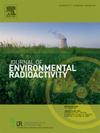日本福岛县一个城市池塘净化后 137Cs 的长期动态变化。
IF 1.9
3区 环境科学与生态学
Q3 ENVIRONMENTAL SCIENCES
引用次数: 0
摘要
由于汇水区的输入,137Cs 往往会在池塘和水坝水库中积累。受福岛第一核电站事故污染的池塘已被净化。然而,人们很少关注去污措施(如清除底泥)后 137Cs 的累积情况,尤其是据报道其城市集水区中 137Cs 浓度较高的城市池塘。本研究考察了净化后 137Cs 的长期积累情况,以评估城市地区的影响。2019 年至 2022 年期间,在日本福岛县郡山市的一个城市池塘收集了底泥以及流入水、池塘水和流出水。净化后,底层沉积物中 137Cs 的平均存量变化不大,介于 271 到 337 kBq/m2 之间,但变异性有所增加。在 2018 年的底层沉积物中,137Cs 浓度与δ15N 呈明显正相关,δ15N 是底层沉积物污染源贡献的指标,但在 2019 年之后则不再相关。比表面积与底泥中 137Cs 浓度之间的相关性在 2020 年后明显呈正相关。这些结果表明,在净化后立即沉积有人类活动土地上的颗粒的地点,137Cs 浓度较高;此后,在细颗粒沉积地点,137Cs 浓度较高。从 2019 年到 2022 年,池塘水体中 137Cs 的年均浓度保持稳定。流入水中悬浮固体和溶解部分的 137Cs 平均归一化浓度分别为 0.041 m2/kg 和 21.2 × 10-5 m-1。这些数值高于其他低城市集水区水生环境的报告值。不过,尽管悬浮固体中的 137Cs 浓度很高,但流入水体的 137Cs 负荷不太可能足以增加底泥中的 137Cs 库存。城市地区 137Cs 污染持续存在的机理值得进一步研究。本文章由计算机程序翻译,如有差异,请以英文原文为准。

Long-term 137Cs dynamics after decontamination of an urban pond in Fukushima Prefecture, Japan
137Cs tends to accumulate in ponds and dam reservoirs because of inputs from their catchments. Ponds contaminated by the Fukushima Daiichi Nuclear Power Plant accident have since been decontaminated. However, little attention has been paid to 137Cs accumulation after the decontamination measures, such as bottom sediment removal, especially for urban ponds with reportedly high 137Cs concentrations in their urban catchments. This study examined long-term 137Cs accumulation after decontamination to assess the influence of urban areas. Between 2019 and 2022, bottom sediment was collected together with inflow, pond, and outflow water at an urban pond located at Koriyama City, Fukushima Prefecture, Japan. The mean 137Cs inventory in the bottom sediment did not change significantly after decontamination, ranging from 271 to 337 kBq/m2, whereas the variability increased. A significantly positive correlation of the 137Cs concentration with δ15N, an indicator of the source contribution to bottom sediment, was determined in the bottom sediment in 2018 but not after 2019. The correlation between the specific surface area and 137Cs concentration in the bottom sediment was significantly positive after 2020. These results suggested higher 137Cs concentrations at sites where particles from land hosting human activities were deposited immediately after decontamination; thereafter, 137Cs concentrations were higher at sites of fine-particle deposition. The annual mean 137Cs concentration in pond water was stable from 2019 to 2022. The mean-normalized 137Cs concentrations in the suspended solids and dissolved fractions in the inflow water were 0.041 m2/kg and 21.2 × 10−5 m−1, respectively. These values were higher than those reported for other aquatic environments with low-urban catchment. However, the 137Cs load from inflows was unlikely to have been enough to increase the 137Cs inventory in the bottom sediment, despite the high 137Cs concentration in suspended solids. The mechanism of the persistent 137Cs contamination in urban areas merits further investigation.
求助全文
通过发布文献求助,成功后即可免费获取论文全文。
去求助
来源期刊

Journal of environmental radioactivity
环境科学-环境科学
CiteScore
4.70
自引率
13.00%
发文量
209
审稿时长
73 days
期刊介绍:
The Journal of Environmental Radioactivity provides a coherent international forum for publication of original research or review papers on any aspect of the occurrence of radioactivity in natural systems.
Relevant subject areas range from applications of environmental radionuclides as mechanistic or timescale tracers of natural processes to assessments of the radioecological or radiological effects of ambient radioactivity. Papers deal with naturally occurring nuclides or with those created and released by man through nuclear weapons manufacture and testing, energy production, fuel-cycle technology, etc. Reports on radioactivity in the oceans, sediments, rivers, lakes, groundwaters, soils, atmosphere and all divisions of the biosphere are welcomed, but these should not simply be of a monitoring nature unless the data are particularly innovative.
 求助内容:
求助内容: 应助结果提醒方式:
应助结果提醒方式:


